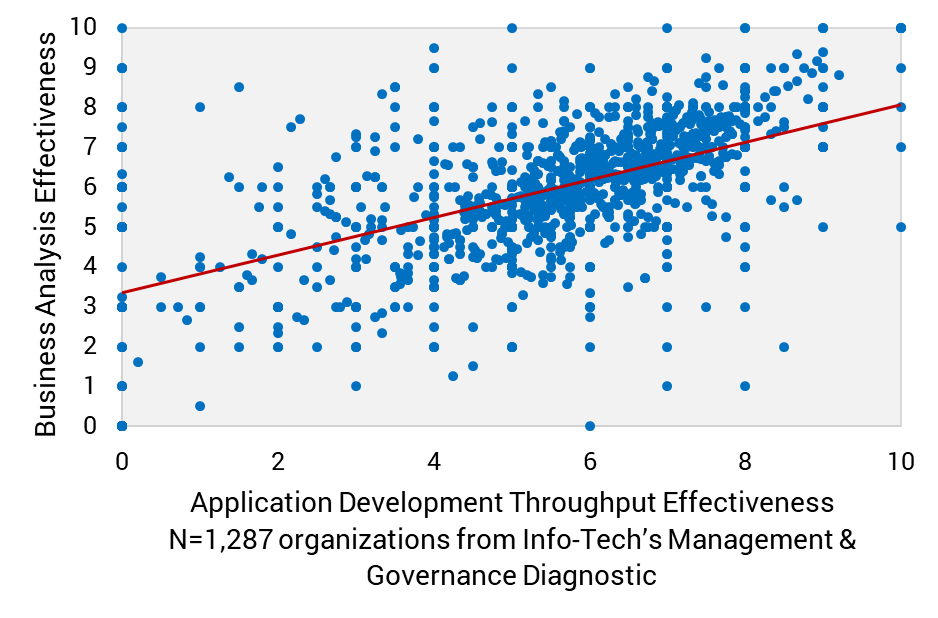Is Agile … Limiting for Business Analysts?
Receive free IIBA updates and exclusive content!
Business Analysis Capability Fit in Scaling Agile Part 3: Based on IIBA quarterly Corporate Leader Webinar with Info-Tech’s Allison Straker
Agile shifts how business analysis is done, but it doesn’t change the fact that business analysis needs to be done. Our research has shown the direct relationship that requirements have with the throughput of the development team.
Rather than doing analysis at the beginning of an initiative, in Agile initiatives analysis is ongoing. Analysis will not be thorough at the beginning of an entire initiative; it will be done in just enough detail to ensure that the stories that are needed for the release can be done.

Alignment to BABOK Knowledge Areas
The Agile Extension to the BABOK® Guide does an excellent job of mapping the BABOK Knowledge Areas to those used in Agile. The guide refers to 3 horizons – strategy, initiative, and delivery; the strategy horizon most aligns with the analysis required to scale agile. It shows that agile accounts for all of the knowledge areas; a summary is below:
| Business Analysis Planning & Monitoring | Planning and stakeholder engagement occur not just at the beginning of team’s work, but throughout the initial strategy and actual development of the product. Planning involves just what’s required, rather than covering planning for the entire evolution of product(s). |
| Elicitation & Collaboration |
The Agile Extension says it best: “The focus of conducting elicitation is continuous and spans across all initiatives, throughout the organization, and spans beyond the boundaries of the organization” Elicitation and collaboration are ongoing, analysts must continually refine what is required to be developed and released. |
| Requirements Lifecycle Management |
Scaled agile initiatives ensure that changes across initiatives do not have a negative cross impact. Rather than maintaining a static set of requirements, initiatives must maintain a good but subject to change understanding of customer needs. The understanding of the customer will evolve as the team/organization learns from experiments and delivered stories; initiatives must change with each new learning. Prioritization occurs in both agile and non-agile initiatives. Goals will be prioritized at the organizational level, and teams will focus on prioritizing team delivery backlog items. Change assessment is also accounted for in agile/scaled agile. Backlog refinement and changes across teams are both relevant and important. The requirements lifecycle also includes communication and decision-making. Individual teams are empowered to make decisions through their Product Owner. They need to ensure that they are in alignment with organizational goals and are not in conflict with other teams. |
| Strategy Analysis | In Agile initiatives, current state, future state, and risk analysis are assessed collaboratively. They are continuously reviewed and explored to ensure the ongoing impact of change is understood. On a team basis, risk analysis helps in prioritization of backlog items. |
| Requirements Analysis & Design Definition |
In agile initiatives, both organizational goals and team deliverables are modelled lightly – just enough to facilitate communications. Verification and validation ensure that initiatives are meeting organizational goals and ensure a shared understanding. The structure and organization of requirements – requirements architecture – is also accounted for through organizational alignment and refined through retrospectives, prioritization, as well as ensuring that the backlog contains required enablers. |
| Solution Evaluation | Solution evaluation describes the tasks required to assess the performance and value delivered, as well as limitations. It involves continuous evaluation (via feedback and retrospectives) to ensure organizational goals are met for all initiatives under way. |
While important factors to consider in choosing your scaled Agile framework include the size of the organization, your processes, and whether you are highly regulated, you should not ignore the organizations culture, communication styles, and the types of products your organization creates.
Corporate Leader Webinar is one of the benefits of IIBA’s Corporate Program.
Corporate Leaders help select topics that would be beneficial to Business Analysis leaders and their communities. Each quarter features a new topic and speaker. To hear more about IIBA’s Corporate Program and receive the full excerpt, please email corporatemembership@iiba.org.
Tell Me More!
Stay tuned for next week’s blog to answer more of your questions. To receive the full excerpt now and learn how IIBA’s Global Corporate Program can help your organization get better results from your Agile Analysis initiatives complete the form below.
Reach out to a program manager now.

In case you missed it:
Part 1: Why Scaling Agile is Essential for Your Organization
Part 2: Business Analysis Has a Role in Your Agile Transformation
References:
Info-Tech has done extensive research on Agile and Requirements. Review some of our articles and blueprints (research) below, and reach out to our team to find out how you can access more information:
Agile Skills Don’t Revolve Around Ceremonies and Procedures: They’re About Traits and Values.
Agile Doesn’t Mean No Requirements
BizDevOps Starts with Great Requirements
Implement Agile Practices That Work
Transition to Product Delivery
Build a Better Backlog

